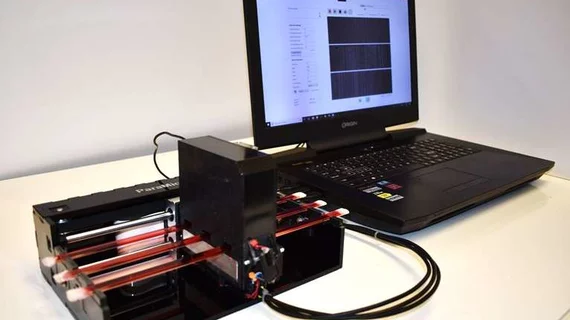AI, microscopic imaging mobile device detects parasitic infections in 20 minutes
The diagnosis of parasitic infections may become a more widely available and accurate medical service with the help of a new portable artificial intelligence (AI) and microscopy-based technology developed by researchers at the University of California, Los Angeles (UCLA).
The new platform—which can detect motile parasites in bodily fluids automatically, and analyze more than three milliliters of a bodily fluid sample in 20 minutes—provides images clearer than those from traditional optical microscopy, according to research published online Dec. 12 in the journal Light: Science & Applications.
The platform detects motion within a patient's bodily fluid sample and records holographic patterns of the sample that are illuminated with a laser light. A motion analysis AI algorithm then reads the micro-scale videos and converts the locomotion of the target parasites within the sample into a signal spot, according to the researchers.
"Our platform can be considered as a motion detector in the microscopic world, which locks onto any moving objects within the sample," first study author Yibo Zhang, PhD, a UCLA doctoral student, said in a prepared statement. "Locomotion is used as both a biomarker and a contrast mechanism to distinguish parasites from normal cells."
The detection limit of the device was also quantified as 10 parasites per milliliter of whole blood and is five-times better than the current parasitological detection methods, according to the researchers.
The team hopes the improved detection limit of the device may lead to better capability for detecting sleeping sickness and identifying Chagas disease earlier to provide treatment.
The device is compact and lightweight (1.69 kilograms) and the cost of the prototype is less than $1,850, according to a UCLA news release.
"Thanks to its high sensitivity, ease-of-use, reduced cost and portability, we believe our technique can improve parasite screening efforts, especially in resource-poor areas and endemic regions," study co-author Hatice Ceylan Koydemir, PhD, a UCLA postdoctoral scholar, said in the prepared statement.
Related Chagas Disease Content:
Chagas disease increases the risk of CVD
Chagas parasitic heart disease threat creeps into U.S.
Algorithm unmasks bugs bearing diseases
Chagas disease among topics at HRS 2019
AI, microscopic imaging mobile device detects parasitic infections in 20 minutes
RSNA 2016: How imaging can help treat Zika, other tropical diseases

